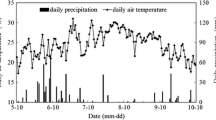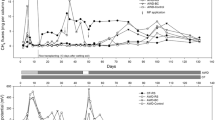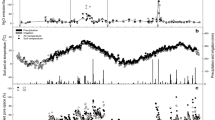Abstract
Organic matter addition is thought to be an important regulator of nitrous oxide (N2O) emissions from croplands. Contradictory effects, however, were reported in previous studies. To investigate the effects of crop residue management on N2O emissions from rice-wheat rotation ecosystems, we conducted field experiments at three sites (Suzhou, Wuxi and Jiangdu) in the Yangtze River Delta, using static chamber and gas chromatography methods. Our data show that N2O emissions throughout the rice season from plots treated with wheat straw application at a high rate (WS) prior to rice transplanting (1.1–2.0 kg N ha−1) were significantly lower (P < 0.05) than those from the control plots without organic matter addition or added with wheat straw at a moderate rate (1.6–2.9 kg N ha−1). Furthermore, the WS treatments had a residual inhibitory effect on N2O emissions in the following non-rice season, which consistently resulted in significantly lower emissions (P < 0.05) compared to the control treatments (2.2–3.1 vs. 3.9–5.6 kg N ha−1). In comparison to the control treatments, the WS treatments reduced both the seasonal and annual direct emission factors of the applied nitrogen (EFd) by 50–68% (mean: 57%). The addition of compost (aerobically composted rice or wheat straw harvested in the last rotation) reduced the seasonal and annual EFds by 29–32%. Over the entire rice-wheat rotation cycle, annual N2O emissions from the fertilized fields at the three sites ranged from 3.3 ± 0.3 to 16.8 ± 0.6 kg N ha−1, with a coefficient of variation (CV) of 61%. Similarly, the EFds during the rice-wheat rotation cycle ranged from 0.4% to 2.5%, with a CV of 67%. These high spatial variations might have been related to: variations in soil properties, such as texture and soil organic carbon; management practices, such as straw treatments (i.e., compost versus fresh straw) and weather conditions, such as precipitation and rainfall distribution. Our results indicate that the incorporation of fresh wheat straw at a high rate during the rice season is an effective management practice for the mitigation of N2O emissions in rice-wheat rotation systems. Whether this practice is also effective in reducing the overall global warming potential of net N2O, CH4 and CO2 emissions needs to be seen through further studies.





Similar content being viewed by others
References
Akiyama H, Tsuruta H (2003) Effect of organic matter application on N2O, NO and NO2 fluxes from an Andisol field. Global Biogeochem Cycles 17. doi:10.1029/2002GB002016
Akiyama H, Yagi K, Yan XY (2005) Direct N2O emissions from rice paddy fields: summary of available data. Global Biogeochem Cycles l9. doi:10.1029/2004GB002378
Aulakh MS, Doran DT, Walter DT, Mosier AR, Francis DD (1991) Crop residue type and placement effects on denitrification and mineralization. Soil Sci Soc Am J 55:1020–1025
Aulakh MS, Khera TS, Doran JW, Bronson KF (2001) Denitrification, N2O and CO2 fluxes in rice-wheat cropping system as affected by crop residues, fertilizer N and legume green manure. Biol Fertil Soils 34:375–389
Baggs EM, Rees RM, Smith KA, Vinten AJA (2000) Nitrous oxide emission from soils after incorporating crop residues. Soil Use Manage 16:82–87
Baggs EM, Millar N, Ndufa JK, Cadisch G et al (2001) In: Rees RM (ed) Effect of residue quality on N2O emissions from tropical soils, in sustainable management of soil organic matter. CAB Int., Wallingford, pp 120–125
Baggs EM, Chebii J, Ndufa JK (2006) A short-term investigation of trace gas emissions following tillage and no-tillage of agroforestry residues in western Kenya. Soil Till Res 90:69–76
Bouwman AF, Boumans LJM, Batjes NH (2002) Emissions of N2O and NO from fertilized fields: summary of available measurement data. Global Biogeochem Cycles l6. doi:10.1029/2001GB001811
Bronson KF, Neue HU, Singh U, Abao EB (1997) Automated chamber measurements of methane and nitrous oxide flux in a flooded rice soil:2, Fallow period emissions. Soil Sci Soc Am J 61:988–993
Byrnes BH, Holt LS, Austin ER (1993) The emission of nitrous oxide upon wetting a rice soil following a dry season fallow. J Geophys Res Atmos 98:22925–22929
Cai Z, Xing G, Yan X, Xu H, Tsuruta H, Yagi K, Minami K (1997) Methane and nitrous oxide emissions from rice paddy fields as affected by nitrogen fertilizers and water management. Plant Soil 196:7–14
Cochran VL, Sparrow EB, Schlentner SF, Knight CW (1997) Long-term tillage and crop residue management in the subarctic: fluxes of methane and nitrous oxide. Can J Soil Sci 77:565–570
Constantinides M, Fownes JH (1994) Nitrogen mineralization from leaves and litter of tropical plants: relationship to nitrogen, lignin and soluble polyphenol concentrations. Soil Biol Biochem 26:49–55
Cooperative Research Group on Chinese Soil Taxonomy (2001) Chinese soil taxonomy. China Science and Technology, China, pp 221–223
Davidson EA, Matson PA, Brooks PD (1996) Nitrous oxide emission controls and inorganic nitrogen dynamics in fertilized tropical agricultural soils. Soil Sci Soc Am J 60:1145–1152
Dobbie KE, McTaggart IP, Smith KA (1999) Nitrous oxide emissions from intensive agricultural systems: variations between crops and seasons, key driving variables, and mean emission factors. J Geophys Res Atmos 104:26891–26899
Flessa H, Beese F (1995) Effect of sugarbeet residues on soil redox potential and nitrous oxide emission. Soil Sci Soc Am J 59:1044–1051
Forster P, Ramaswamy V, Artaxo P, Berntsen T, Betts R, Fahey DW, Haywood J, Lean J, Lowe DC, Myhre G, Nganga J, Prinn R, Raga G, Schulz M, Van Dorland R (2007) Changes in atmospheric constituents and in radiative forcing. In: Solomon S, Qin D, Manning M, Chen Z, Marquis M, Averyt KB, Tignor M, Miller HL (eds) Climate change 2007: the physical science basis. Contribution of working group I to the fourth assessment report of the intergovernmental panel on climate change. Cambridge University Press, Cambridge
Fox RH, Myers RJK, Vallis I (1990) The nitrogen mineralization rate of legume residues in soil as influenced by their polyphenol, lignin and nitrogen contents. Plant Soil 129:251–259
Granli T, Bockman OC (1994) Nitrous oxide from agriculture. Nor J Agric Sci 12(Suppl):7–127
Handayanto E, Cadisch G, Giller KE (1994) Nitrogen release from prunings of legume hedgerow trees in relation to quality of the prunings and incubation method. Plant Soil 160:237–248
Huang Y, Zou J, Zheng X, Wang Y, Xu X (2004) Nitrous oxide emissions as influenced by amendment of plant residues with different C: N ratios. Soil Biol Biochem 36:973–981
IPCC (Intergovernmental Panel on Climate Change) (2007) In: Solomon S, Qin D, Manning M, Chen Z, Marquis M, Averyt KB, Tignor M, Miller HL (eds) Climate change 2007: the physical science basis, contribution of working group I to the fourth assessment report of the intergovernmental panel on climate change. Cambridge University Press, Cambridge
Kaiser EA, Kohrs K, Kucke M, Schnug E, Heinemeyer O, Munch JC (1998) Nitrous oxide release from arable soil :importance of N-fertilzation, crops and temporal variation. Soil Biol Biochem 30:1553–1563
Kroon PS, Hensen A, van den Bulk WCM, Jongejan PAC, Vermeulen AT (2008) The importance of reducing the systematic error due to non-linearity in N2O flux measurements by static chambers. Nutri Cycl Agroecosyst 82:175–186
Lemke RL, Izaurralde RC, Nyborg M, Solberg ED (1999) Tillage and N source influence soil-emitted nitrous oxide inn the Alberta Parkland region. Can J Soil Sci 79:15–24
Li CS, Frolking S, Butterbach-Bahl K (2005) Carbon sequestration in arable soils is likely to increase nitrous oxide emissions, offsetting reductions in climate radiative forcing. Climatic Change 72:321–338
Martikainen PJ, De Boer W (1993) Nitrous oxide production and nitrification in acidic soil from a Dutch coniferous forest. Soil Biol Biochem 25:343–347
Melillo JM, Aber JD, Muratore JF (1982) Nitrogen and lignin control of hardwood leaf litter decomposition dynamics. Ecology 63:621–626
Millar N, Baggs EM (2005) Relationships between N2O emissions and water-soluble C and N contents of agroforestry residues after their addition to soil. Soil Biol Biochem 37:605–608
Millar N, Ndufa JK, Cadisch G, Baggs EM (2004) Nitrous oxide emissions following incorporation of improved-fallow residues in the humid tropics. Global Biogeochem Cycles l8 GB1032. doi:10.1029/2003GB002114
Olk DC, Cassman KG, Randall EW, Kinchesh P, Sanger LJ, Anderson JM (1996) Changes in chemical properties of organic matter with intensified rice cropping in tropical lowland soil. Eur J Soil Sci 47:293–303
Palm CA, Sanchez PA (1991) Nitrogen release from the leaves of some tropical legumes as affected by their lignin and polyphenolic contents. Soil Biol Biochem 23:83–88
Pathak H, Bhatia A, Prasad S, Singh S, Kumar S, Jain MC, Kumar U (2002) Emissions of nitrous oxide from rice-wheat systems of Indo-Gangetic plains of India. Environ Monit Assess 77:163–178
Seneviratne G (2000) Litter quality and nitrogen release in tropical agriculture: a synthesis. Biol Fertil Soils 31:60–64
Sitaula BK, Bakken LR (1993) Nitrous oxide release from spruce forest soil: relationships with nitrification, methane uptake, temperature, moisture and fertilization. Soil Biol Biochem 25:1415–1421
Skiba U, Smith KA, Fowler D (1993) Nitrification and denitrification as a source of nitric oxide and nitrous oxide in a sandy loam soil. Soil Biol Biochem 25:1527–1536
Smith CJ, Patrick WH Jr (1983) Nitrous oxide emission as affected by alternate anaerobic and aerobic conditions from soil suspensions enriched with (NH4) 2SO4. Soil Biol Biochem 15:693–696
Stehfest E, Bouwman L (2006) N2O and NO emission from agricultural fields and soils under natural vegetation: summarizing available measurement data and modeling of global annual emissions. Nutr Cycl Agroecosyst 74:207–228
Stott DE, Elliott LF, Papendick RI, Campbell GS (1986) Low temperature or low water effects on microbial decomposition of wheat residue. Soil Biol Biochem 18:577–582
Toma Y, Hatano R (2007) Effect of crop residue C: N ratio on N2O emissions from Gray Lowland soil in Mikasa, Hokkaido, Japan. Soil Sci Plant Nutr 53:198–205
Velthof GL, Oenema O (1995) Nitrous oxide fluxes from grassland in the Netherlands: II, Effects of soil type, nitrogen fertilizer application and grazing. Eur J Soil Sci 46:541–549
Vigil MF, Kissel DE (1991) Equations for estimating the amount of nitrogen mineralization from crop residues. Soil Sci Soc Am J 57:66–72
Wang YS, Wang YH (2003) Quick measurement of CH4, CO2 and N2O emissions from a short-plant ecosystem. Adv Atmos Sci 20:842–844
Weier KL, Gillam JW (1986) Effect of acidity on nitrogen mineralization and nitrification in Atlantic Coastal Plain soils. Soil Sci Soc Am J 50:1210–1214
Xing GX (1998) N2O emission form cropland in China. Nutr Cycl Agroecosyst 52:249–254
Xing GX, Zhu ZL (1997) Preliminary studies on N2O emission fluxes from upland and paddy soils in China. Nutr Cycl Agroecosyst 49:17–22
Xing GX, Shi SL, Shen GY, Du LJ, Xiong ZQ (2002) Nitrous oxide emissions from paddy soils in three rice-based cropping systems in China. Nutr Cycl Agroecosyst 64:135–143
Xu H, Xing G, Cai Z, Tsuruta H (1997) Nitrous oxide emissions from three rice paddy fields in China. Nutr Cycl Agroecosyst 49:23–28
Zheng X, Wang M, Wang Y, Shen R, Gou J, Li J, Jin J, Li L (2000) Impacts of soil moisture on nitrous oxide emission from croplands: a case study on the rice-based agro-ecosystem in Southeast China. Chemosphere-Global Change Sci 2:207–224
Zheng X, Mei B, Wang YH, Xie B, Wang YS, Dong H, Xu H, Chen G, Cai Z, Yue J, Gu J, Su F, Zou J, Zhu J (2008) Quantification of N2O fluxes from soil-plant systems may be biased by the applied gas chromatograph methodology. Plant Soil 311:211–234
Zou JW, Huang Y, Jiang JY, Zheng XH, Sass RL (2005) A 3-year field measurement of methane and nitrous oxide emissions from rice paddies in China: effects of water regime, crop residue, and fertilizer application. Global Biogeochem Cycles 19, GB2021. doi:10.1029/2004GB002401
Acknowledgements
This work was financially supported by the Chinese Academy of Sciences (KZCX2-YW-204, KZCX3-SW-440), the National Natural Science Foundation of China (40425010), the European Union (NitroEurope IP 017841) and the Helmholtz-CAS Joint Laboratory project ENTRANCE. Furthermore we sincerely thank Dr. S. Han, Dr. C. Liu and Mr. G. Liu for their fruitful technical assistance in field measurements.
Author information
Authors and Affiliations
Corresponding author
Additional information
Responsible Editor: Per Ambus.
Rights and permissions
About this article
Cite this article
Yao, Z., Zhou, Z., Zheng, X. et al. Effects of organic matter incorporation on nitrous oxide emissions from rice-wheat rotation ecosystems in China. Plant Soil 327, 315–330 (2010). https://doi.org/10.1007/s11104-009-0056-4
Received:
Accepted:
Published:
Issue Date:
DOI: https://doi.org/10.1007/s11104-009-0056-4




